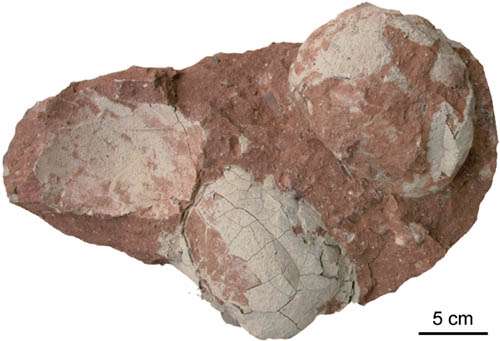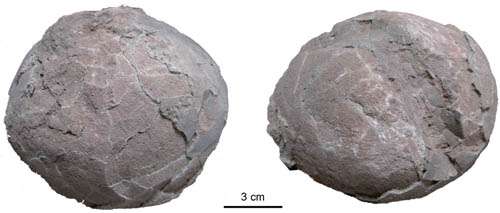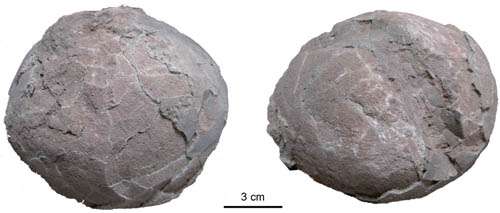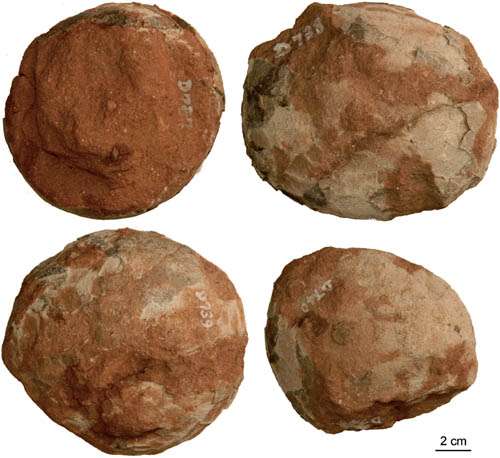New forms of dinosaur eggs (Dictyoolithids) found

Paleontologists from the Institute of Vertebrate Paleontology and Paleoanthropology (IVPP), Chinese Academy of Sciences, collected some dinosaur eggs of the oofamily Dictyoolithidae from the Upper Cretaceous Chichengshan Formation in the Tiantai Basin of Zhejiang Province. On the basis of general external shape, size, eggshell thickness, and eggshell composed of 3-4 superimposed slender shell units with a reticulate organization, researchers established a new oogenus and two oospecies, Paradictyoolithus zhuangqianensis oogen. et oosp. nov., and P. xiaxishanensis oogen. et oosp. nov., as reported in the January issue of Vertebrata PalAsiatica 2013 (1).
The Upper Cretaceous strata of the Tiantai Basin consist of the Laijia Formation and the overlying Chichengshan Formation. The Laijia Formation is composed of lacustrine sediments such as red silty mudstones and granule conglomerates, with many layers of interbedded laminated tuffs. The Chichengshan Formation can be subdivided into two members. The lower member, which has yielded a large number of dinosaur eggs and bones, is composed of red conglomerates, sandstones, and silty mudstones with interbedded tuffs; whereas the upper member is composed of red conglomerates and sandstones interbedded with muddy siltstones. SIMS U-Pb zircon dating of the Laijia and Chichengshan formations indicated an age of 98–91 Ma, corresponding to the early Late Cretaceous (Cenomanian-Turonian).

Eggs of Paradictyoolithus zhuangqianensis is nearspherical, similar to those of Dictyoolithus, but the eggshell is composed of three or four superimposed shell units with a reticulate organization, and shell units connect to each other, forming a honeycomb-like structure in tangential section through the middle part of the eggshell. Therefore, these eggs are referred to a new dictyoolithid oogenus and oospecies.
Eggs of Paradictyoolithus xiaxishanensis is near-spherical, irregularly arranging in the nest. The eggshell composed of three or four superimposed shell units, and shell units are not fused near the outer surface, quite different from those eggs of Paradictyoolithus zhuangqianensis.

The Dictyoolithidae is previously represented by one oogenus and four oospecies, Dictyoolithus hongpoensis, D. neixiangensis, D. jiangi, and D. gongzhulingensis, all of which are known exclusively from the Cretaceous of China. As previous descriptions of the dictyoolithid eggs are brief due to the scarcity of materials for comparison, researchers re-examined the holotypes of the four oospecies, and established a new oogenus Protodictyoolithus, and propose only D. hongpoensis belong to the Dictyoolithus, the other that three species of Dictyoolithus should be reassigned to Protodictyoolithus neixiangensis comb. nov., P. jiangi comb. nov. and Similifaveoolithus gongzhulingensis comb. nov., respectively.

"The newly discovered dinosaur eggs are very important for understanding the composition of the Tiantai dinosaur eggs oofauna and providing new materials to study the eggshell formation and evolution of the dinosaur eggs in the Cretaceous", said first author WANG Qiang of the IVPP.
More information: www.ivpp.cas.cn/cbw/gjzdwxb/xb … 0130131_3759376.html
Journal information: Vertebrata PalAsiatica



















